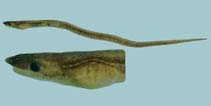| Family: |
Ophichthidae (Snake eels), subfamily: Myrophinae |
| Max. size: |
35 cm TL (male/unsexed) |
| Environment: |
reef-associated; marine; depth range 2 - 35 m |
| Distribution: |
Indo-Pacific: Chagos Islands to the Hawaiian, Marquesas, and Society Islands. Also reported from Australia (Ref. 2334) and New Caledonia (Ref. 13236). |
| Diagnosis: |
Dorsal spines (total): 0-0; Dorsal soft rays (total): 0-0; Anal spines: 0-0; Anal soft rays: 0-0; Vertebrae: 153-159. Description: Characterized by bluish grey color, grading to white ventrally; head length 8-9 in TL; laterally compressed body and tail; greatest depth of body 24-35 in TL; origin of dorsal fin 1.3-1.5 head length behind anus; dorsal and anal fins confluent with caudal fin; no pectoral fins; rounded snout, slightly projecting beyond lower jaw; anterior nostrils tubular about two-thirds eye diameter; posterior nostrils anterior to front edge of eye, opening at edge of upper lip and covered by flap; relatively large eye, posterior edge above corner of mouth; small gill opening, slightly below midlateral position; conical teeth small, in 2-3 rows in upper jaw and about four rows in lower jaw; vomer without teeth (Ref. 90102). |
| Biology: |
Feeds small fishes, crabs, and prawns (Ref. 1602). Benthic (Ref. 58302). Inhabits sand bottoms among coral reefs in 2-23 m. |
| IUCN Red List Status: |
Least Concern (LC); Date assessed: 27 November 2019 Ref. (130435)
|
| Threat to humans: |
harmless |
| Country info: |
|
Source and more info: www.fishbase.org. For personal, classroom, and other internal use only. Not for publication.

